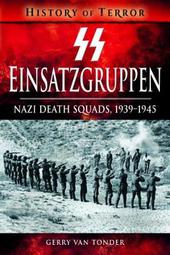
|
SS Einsatzgruppen: Nazi Death Squads, 1939-1945
Paperback / softback
Main Details
| Title |
SS Einsatzgruppen: Nazi Death Squads, 1939-1945
|
| Authors and Contributors |
By (author) Gerry Van Tonder
|
| Series | A History of Terror |
|---|
| Physical Properties |
| Format:Paperback / softback | | Pages:128 | | Dimensions(mm): Height 234,Width 156 |
|
| Category/Genre | Genocide and ethnic cleansing
The Holocaust
Second world war |
|---|
| ISBN/Barcode |
9781526729095
|
| Classifications | Dewey:940.54217 |
|---|
| Audience | |
|---|
| Illustrations |
80 black and white illustrations
|
|
Publishing Details |
| Publisher |
Pen & Sword Books Ltd
|
| Imprint |
Pen & Sword Military
|
| NZ Release Date |
10 September 2018 |
| Publication Country |
United Kingdom
|
Description
In June 1941, Adolf Hitler, whose loathing of Slavs and Jewish Bolsheviks knew no bounds, launched Operation Barbarossa, throwing 4 million troops, supported by tanks, artillery and aircraft into the Soviet Union. Operational groups of the German Security Service, SD, followed into the Baltic and the Black Sea areas. Their orders: neutralise elements hostile to Nazi domination. Combined SS and SD headquarters were set up in Riga (northern), Mogilev (middle) and Kiev (southern), each with subordinate units of the SD, the Einsatzgruppen, and lower echelons of Einsatzkommandos. Communist and Soviet NKVD (People's Commissariat for Internal Affairs) agents were targeted, and from August 1941 to March 1943, 4,000 Soviet and communist agents were arrested and executed. In addition, far greater numbers of partisans and communists were shot to ensure political and ethnic purity in the occupied territories. Einsatzgruppe A, under Adolf Eichmann, executed 29,000 people listed as 'Jews' or 'mostly Jews' in Latvia and Lithuania in the early stages of the operation. In the Einsatzgruppe C report for September 1941, there is a comment, "50,000 executions "foreseen" in Kiev". In five months in 1941, Einsatzkommando III commander, Karl Jager, reported killing 138,272 (48,252 men, 55,556 women and 34,464 children). The Einsatzgruppen were death squads their tools the rifle, the pistol and the machine gun. It is estimated that the Einsatzgruppen executed more than 2 million people between 1941 and 1945, including 1.3 million Jews. AUTHOR: Gerry van Tonder was born in Zimbabwe and came to Britain in 1999. He is a full-time historian and a published author. Specialising in military history, Gerry has authored Rhodesian Combined Forces Roll of Honour, 1966 1981; Book of Remembrance: Rhodesia Native Regiment and Rhodesian African Rifles; North of the Red Line (South African Defence Force's border war), and the co-authored definitive Rhodesia Regiment, 1899 1981, a copy of which he presented to the regiment's former colonel-in-chief, Her Majesty the Queen. Gerry has also written on British local history, including Derby in 50 Buildings, Chesterfield's Military Heritage and Mansfield Through Time. He recently started with a series of Cold War titles and Echoes of the Coventry Blitz. 80 b/w illustrations
Author Biography
Born in Southern Rhodesia, now Zimbabwe, historian and author Gerry van Tonder came to Britain in 1999. Specializing in military history, Gerry has authored _Rhodesian Combined Forces Roll of Honour 1966-1981_; _Book of Remembrance: Rhodesia Native Regiment and Rhodesian African Rifles_; _North of the Red Line_ (on the South African border war), and the co-authored definitive _Rhodesia Regiment 1899-1981_. Gerry presented a copy of the latter to the regiment's former colonel-in-chief, Her Majesty the Queen. Gerry writes extensively for several Pen & Sword military history series including 'Cold War 1945-1991', 'Military Legacy' (focusing on the heritage of British cities), 'Echoes of the Blitz', 'Death Squads' (on massacres and genocides) and 'Architects of Terror'.
ReviewsThe book provides important details about the Einsatzgruppen's leadership and organizational hierarchy, and translated memos specifying how the killings were to take place, and operational reports from the field about their missions' accomplishments. Numerous photographs illustrate the text. A grim read, but a necessary one. --Joshua Sinai "Washington Times" (12/1/2019 12:00:00 AM)
|